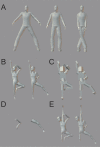Body inversion effect in monkeys
- PMID: 30303982
- PMCID: PMC6179237
- DOI: 10.1371/journal.pone.0204353
Body inversion effect in monkeys
Abstract
Humans visually process human body images depending on the configuration of the parts. However, little is known about whether this function is evolutionarily shared with nonhuman animals. In this study, we examined the body posture discrimination performance of capuchin monkeys, a highly social platyrrhine primate, in comparison to humans. We demonstrate that, like humans, monkeys exhibit a body inversion effect: body posture discrimination is impaired by inversion, which disrupts the configural relationships of body parts. The inversion effect in monkeys was observed when human body images were used, but not when the body parts were replaced with cubic and cylindrical figures, the positions of the parts were scrambled, or only part of a body was presented. Results in human participants showed similar patterns, though they also showed the inversion effect when the cubic/cylindrical body images were used. These results provide the first evidence for configural processing of body forms in monkeys and suggest that the visual attunement to social signals mediated by body postures is conserved through the evolution of primate vision.
Conflict of interest statement
The authors have declared that no competing interests exist.
Figures




Similar articles
-
Contributions of visual and embodied expertise to body perception.Perception. 2012;41(4):436-46. doi: 10.1068/p7029. Perception. 2012. PMID: 22896916
-
Where You Look Matters for Body Perception: Preferred Gaze Location Contributes to the Body Inversion Effect.PLoS One. 2017 Jan 13;12(1):e0169148. doi: 10.1371/journal.pone.0169148. eCollection 2017. PLoS One. 2017. PMID: 28085894 Free PMC article.
-
Internal model of gravity influences configural body processing.Cognition. 2017 Jan;158:208-214. doi: 10.1016/j.cognition.2016.10.018. Epub 2016 Nov 12. Cognition. 2017. PMID: 27842273
-
An inversion effect modified by expertise in capuchin monkeys.Anim Cogn. 2011 Nov;14(6):839-46. doi: 10.1007/s10071-011-0417-2. Epub 2011 May 15. Anim Cogn. 2011. PMID: 21573949
-
Third-party social evaluations of humans by monkeys and dogs.Neurosci Biobehav Rev. 2017 Nov;82:95-109. doi: 10.1016/j.neubiorev.2017.01.003. Epub 2017 Jan 7. Neurosci Biobehav Rev. 2017. PMID: 28077260 Review.
Cited by
-
Body perception in chimpanzees and humans: The expert effect.Sci Rep. 2020 Apr 28;10(1):7148. doi: 10.1038/s41598-020-63876-x. Sci Rep. 2020. PMID: 32345997 Free PMC article.
-
Great apes' understanding of biomechanics: eye-tracking experiments using three-dimensional computer-generated animations.Primates. 2021 Sep;62(5):735-747. doi: 10.1007/s10329-021-00932-8. Epub 2021 Jul 24. Primates. 2021. PMID: 34302253
-
Integration of head and body orientations in the macaque superior temporal sulcus is stronger for upright bodies.Elife. 2025 May 27;14:RP105714. doi: 10.7554/eLife.105714. Elife. 2025. PMID: 40421707 Free PMC article.
-
Ultra-rapid object categorization in real-world scenes with top-down manipulations.PLoS One. 2019 Apr 10;14(4):e0214444. doi: 10.1371/journal.pone.0214444. eCollection 2019. PLoS One. 2019. PMID: 30969988 Free PMC article.
References
-
- Call J, Tomasello M, editors. The gestural communication of apes and monkeys. Mahwah, New Jersey: Lawrence Erlbaum Associates; 2007.

